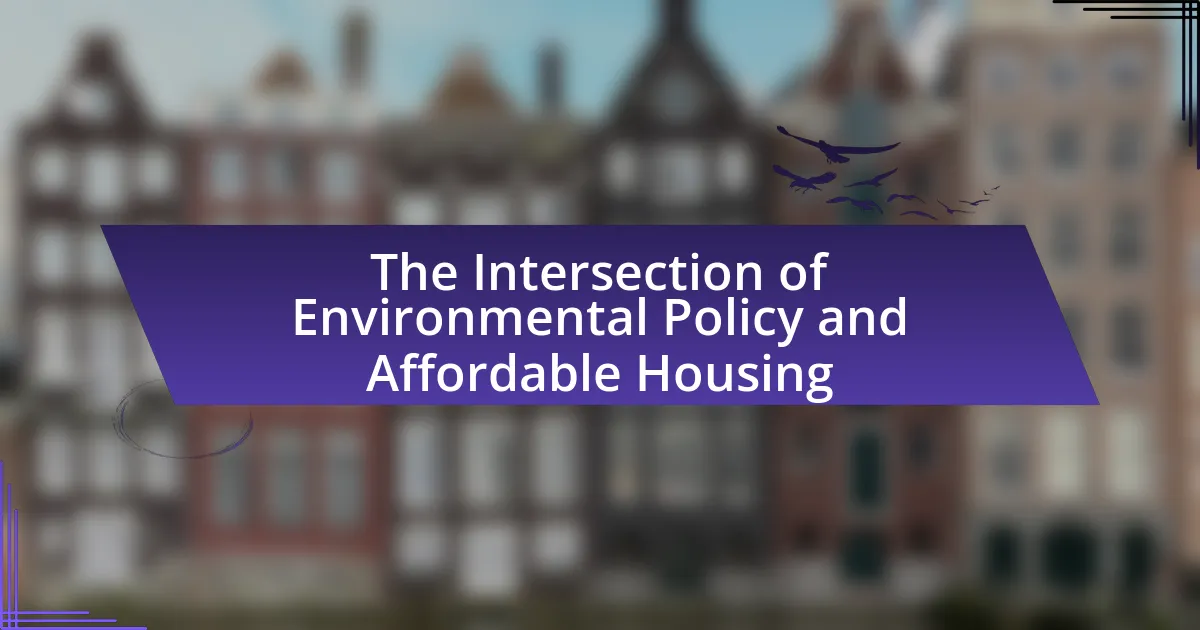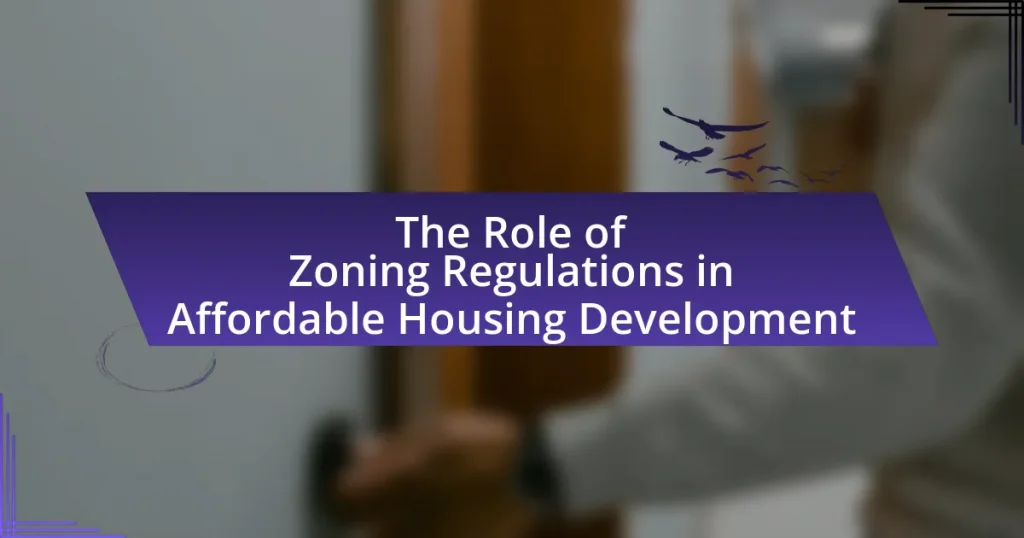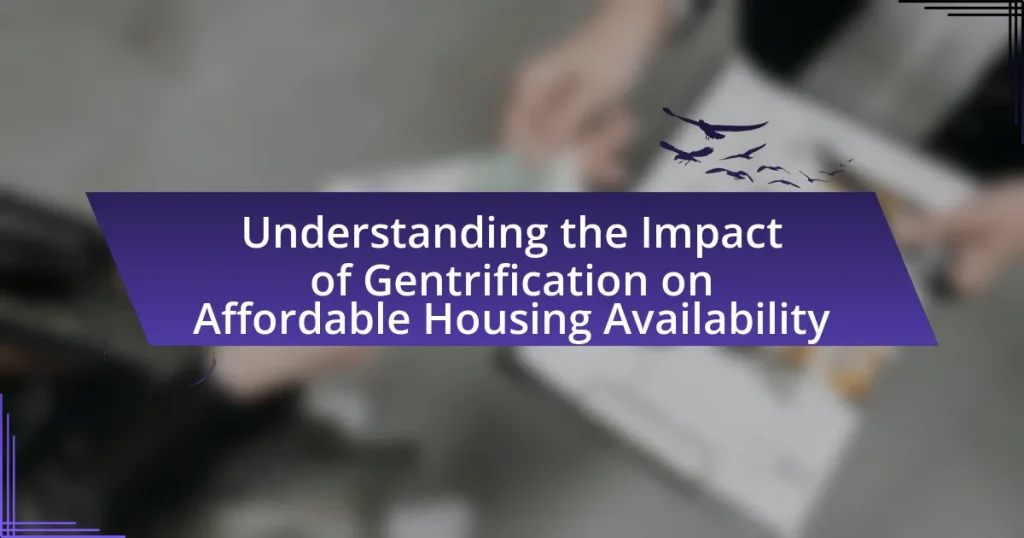The article examines the intersection of environmental policy and affordable housing, highlighting the integration of sustainable practices in housing development to promote ecological preservation and economic accessibility. It discusses how environmental regulations influence housing development, the impact of zoning laws on sustainability, and the role of affordable housing in urban planning. Additionally, the article addresses challenges at this intersection, such as balancing sustainability with cost-effectiveness, and explores innovative solutions and best practices for promoting sustainable affordable housing. Key components of effective environmental policies, the influence of public transportation, and successful case studies from various cities are also analyzed to illustrate the potential for collaboration among stakeholders in addressing these critical issues.
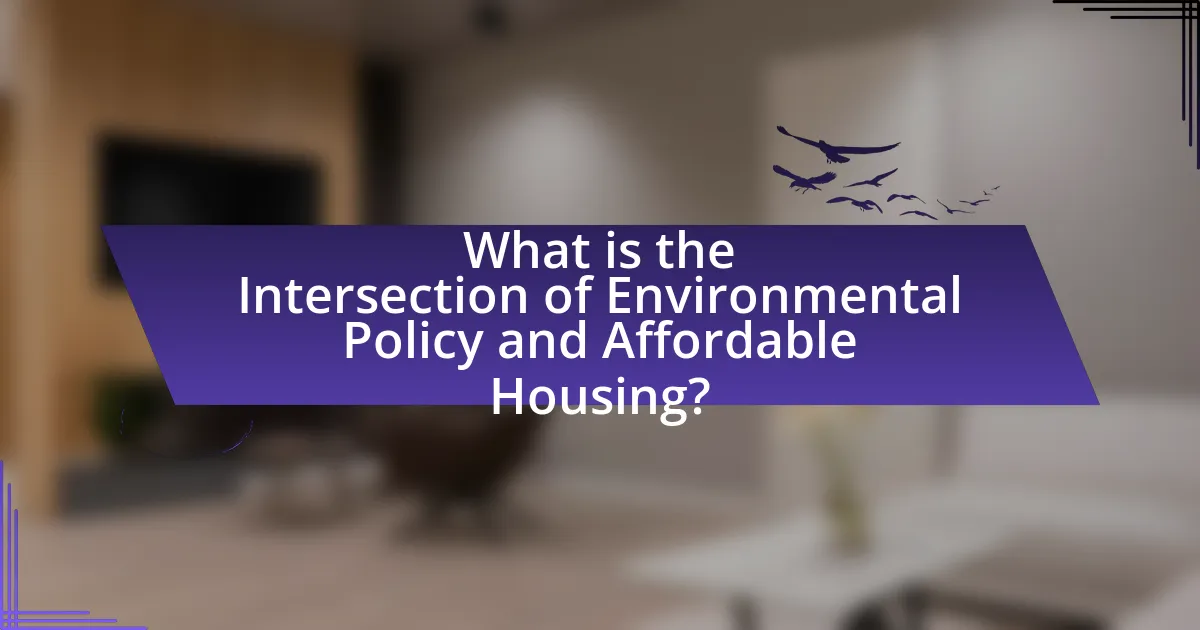
What is the Intersection of Environmental Policy and Affordable Housing?
The intersection of environmental policy and affordable housing involves the integration of sustainable practices in housing development to ensure both ecological preservation and economic accessibility. Environmental policies often promote energy efficiency, sustainable materials, and green infrastructure, which can reduce long-term costs for residents and improve living conditions. For instance, the U.S. Green Building Council’s LEED certification encourages environmentally friendly building practices that can lower utility bills, making housing more affordable over time. Additionally, policies that prioritize affordable housing in urban planning can help reduce urban sprawl, thereby minimizing environmental impact and promoting community resilience.
How do environmental policies influence affordable housing development?
Environmental policies significantly influence affordable housing development by imposing regulations that can either facilitate or hinder construction processes. For instance, policies aimed at reducing carbon emissions may require developers to incorporate sustainable building practices, which can increase initial costs but lead to long-term savings and environmental benefits. Additionally, zoning laws that prioritize green spaces or energy-efficient designs can limit the available land for affordable housing projects, thereby affecting supply. Research from the Urban Institute indicates that stringent environmental regulations can lead to increased housing costs, as developers may pass on compliance costs to consumers. Thus, while environmental policies aim to promote sustainability, they can also create challenges for affordable housing development by impacting costs and land availability.
What specific environmental regulations impact housing projects?
Specific environmental regulations that impact housing projects include the National Environmental Policy Act (NEPA), which requires environmental assessments for federally funded projects, and the Clean Water Act, which regulates discharges into water bodies and may affect site development. Additionally, local zoning laws often incorporate environmental considerations, such as land use restrictions to protect wetlands or endangered species habitats. These regulations ensure that housing projects consider environmental sustainability and community health, influencing design, location, and construction practices.
How do zoning laws relate to environmental sustainability in housing?
Zoning laws significantly influence environmental sustainability in housing by regulating land use, density, and building practices. These laws can promote sustainable development by encouraging higher-density housing, which reduces urban sprawl and preserves green spaces. For instance, zoning regulations that allow mixed-use developments can minimize transportation emissions by enabling residents to live closer to work and amenities. Additionally, certain zoning codes may mandate green building practices, such as energy-efficient designs and the use of sustainable materials, thereby reducing the overall environmental impact of housing. Studies have shown that cities with progressive zoning laws tend to have lower carbon footprints and better resource management, reinforcing the connection between effective zoning and environmental sustainability in housing.
Why is the intersection important for urban planning?
The intersection is crucial for urban planning because it serves as a focal point for transportation, accessibility, and land use. Effective urban planning relies on intersections to facilitate the movement of people and goods, which directly impacts economic activity and community connectivity. Research indicates that well-designed intersections can enhance safety, reduce traffic congestion, and promote sustainable transportation options, such as walking and cycling. For instance, the National Association of City Transportation Officials reports that improving intersection design can lead to a 40% reduction in pedestrian injuries. Thus, the intersection plays a vital role in shaping urban environments that are efficient, safe, and conducive to sustainable development.
What role does affordable housing play in sustainable urban development?
Affordable housing is essential for sustainable urban development as it promotes social equity, reduces urban sprawl, and enhances economic stability. By providing accessible living options, affordable housing ensures that low- and moderate-income families can reside in urban areas, thereby fostering diverse communities. This inclusivity helps to mitigate the negative impacts of gentrification and displacement, which can lead to social fragmentation.
Moreover, affordable housing contributes to sustainability by encouraging higher density living, which reduces the need for extensive transportation infrastructure and lowers greenhouse gas emissions. According to the American Planning Association, compact, mixed-use developments can significantly decrease reliance on cars, promoting public transit use and walkability.
Additionally, affordable housing initiatives often incorporate energy-efficient designs and sustainable building practices, further supporting environmental goals. For instance, the U.S. Green Building Council reports that green building practices can lead to a 30% reduction in energy consumption, which is crucial for sustainable urban environments. Thus, affordable housing plays a pivotal role in creating resilient, equitable, and environmentally friendly urban spaces.
How can environmental policies enhance community resilience?
Environmental policies can enhance community resilience by promoting sustainable practices that reduce vulnerability to environmental hazards. For instance, policies that encourage green infrastructure, such as urban forests and permeable pavements, can mitigate flooding and improve air quality, thereby strengthening community health and safety. Research indicates that communities with robust environmental policies experience lower disaster recovery times; for example, a study by the National Oceanic and Atmospheric Administration found that cities implementing comprehensive climate adaptation strategies reduced their recovery costs by up to 30%. This evidence underscores the effectiveness of environmental policies in fostering resilience against climate-related challenges.
What challenges arise at the intersection of these two fields?
Challenges at the intersection of environmental policy and affordable housing include balancing sustainability with cost-effectiveness. Environmental regulations often increase construction costs, making it difficult to maintain affordability in housing projects. For instance, implementing energy-efficient technologies can raise initial expenses, which may deter developers from pursuing affordable housing initiatives. Additionally, zoning laws and land-use policies may restrict the development of affordable housing in areas that are environmentally sensitive, leading to a scarcity of available land for such projects. These challenges necessitate innovative solutions that reconcile environmental goals with the urgent need for affordable housing.
What are the common conflicts between environmental goals and housing needs?
Common conflicts between environmental goals and housing needs include land use competition, resource allocation, and regulatory challenges. Urban development often requires land that is ecologically sensitive, leading to habitat destruction and increased carbon emissions, which contradicts environmental sustainability objectives. Additionally, the push for affordable housing can lead to increased energy consumption and waste generation, undermining efforts to reduce environmental footprints. For instance, the construction of new housing developments can lead to deforestation and loss of green spaces, which are critical for carbon sequestration. Furthermore, stringent environmental regulations can delay housing projects, exacerbating housing shortages and increasing costs, which ultimately affects low-income populations disproportionately.
How do funding and resource allocation affect both areas?
Funding and resource allocation significantly impact both environmental policy and affordable housing by determining the availability of financial support and resources for initiatives in these areas. For instance, increased funding for environmental projects can lead to the development of sustainable housing practices, which can enhance energy efficiency and reduce carbon footprints. Conversely, inadequate funding for affordable housing can result in a lack of access to safe and sustainable living conditions, exacerbating social inequalities. Research indicates that cities that allocate resources effectively towards both sectors can achieve better outcomes, such as improved public health and reduced environmental degradation, demonstrating the interconnectedness of these areas.
How can stakeholders collaborate to address these challenges?
Stakeholders can collaborate to address challenges at the intersection of environmental policy and affordable housing by forming partnerships that integrate sustainable practices into housing development. For example, local governments, non-profit organizations, and private developers can work together to create policies that incentivize green building techniques, such as energy-efficient designs and renewable energy sources. Research from the American Council for an Energy-Efficient Economy indicates that energy-efficient homes can reduce utility costs by 30% or more, making housing more affordable while also benefiting the environment. By sharing resources, knowledge, and funding, stakeholders can effectively tackle the dual challenges of providing affordable housing and promoting environmental sustainability.
What innovative solutions exist to bridge the gap?
Innovative solutions to bridge the gap between environmental policy and affordable housing include the implementation of green building standards, the use of modular construction techniques, and the integration of renewable energy sources in housing developments. Green building standards, such as LEED certification, promote energy efficiency and sustainability, which can reduce long-term costs for residents while meeting environmental goals. Modular construction techniques allow for faster and more cost-effective building processes, making affordable housing more accessible. Additionally, integrating renewable energy sources, like solar panels, can lower utility costs for low-income families, further enhancing affordability. These solutions are supported by studies showing that energy-efficient homes can save residents up to 30% on energy bills, thereby making housing more affordable while also addressing environmental concerns.
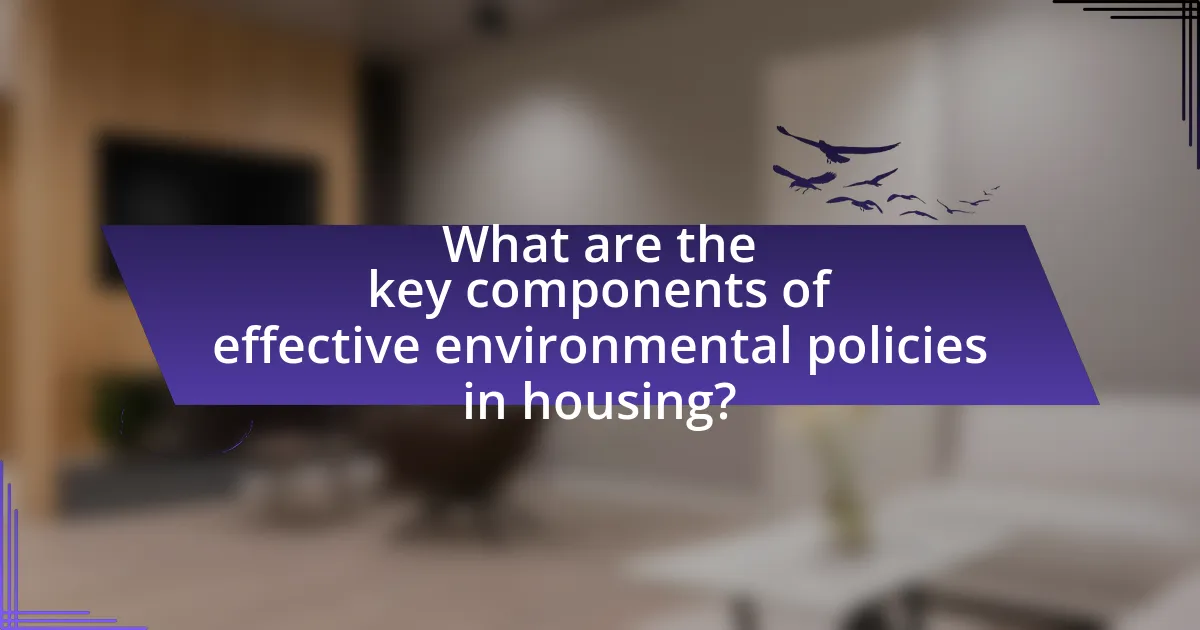
What are the key components of effective environmental policies in housing?
Effective environmental policies in housing include sustainability, energy efficiency, waste management, and community engagement. Sustainability ensures that housing developments minimize environmental impact through the use of renewable resources and eco-friendly materials. Energy efficiency focuses on reducing energy consumption through better insulation, energy-efficient appliances, and renewable energy sources, which can lower utility costs for residents. Waste management involves strategies for reducing, reusing, and recycling materials during construction and throughout the lifecycle of housing. Community engagement fosters collaboration between policymakers, developers, and residents to ensure that housing solutions meet local environmental needs and priorities. These components are essential for creating housing that is not only affordable but also environmentally responsible, contributing to long-term ecological health and community well-being.
How do green building standards impact affordable housing?
Green building standards positively impact affordable housing by promoting energy efficiency and reducing long-term operational costs. These standards, such as LEED and Energy Star, encourage the use of sustainable materials and technologies that lower utility bills, making housing more affordable for low-income residents. For instance, a study by the U.S. Green Building Council found that green buildings can reduce energy consumption by 30% to 50%, which directly benefits tenants through lower monthly expenses. Additionally, green building practices can enhance indoor air quality and overall living conditions, contributing to better health outcomes for residents.
What certifications are available for sustainable housing?
Several certifications are available for sustainable housing, including LEED (Leadership in Energy and Environmental Design), Energy Star, and the National Green Building Standard (NGBS). LEED is a widely recognized certification that evaluates the environmental performance of buildings and encourages market transformation towards sustainable design. Energy Star focuses on energy efficiency and is applicable to homes and commercial buildings, indicating that they meet strict energy performance standards set by the U.S. Environmental Protection Agency. The National Green Building Standard provides a framework for building sustainable homes and is the only green certification approved by the American National Standards Institute. These certifications help ensure that housing meets specific sustainability criteria, promoting energy efficiency, resource conservation, and overall environmental responsibility.
How do energy efficiency measures reduce costs for residents?
Energy efficiency measures reduce costs for residents by lowering utility bills through reduced energy consumption. For instance, implementing energy-efficient appliances and insulation can decrease heating and cooling costs significantly; studies show that households can save between 10% to 50% on energy bills after such upgrades. Additionally, energy efficiency improvements can enhance property value and reduce maintenance costs, as newer systems often require less upkeep. According to the U.S. Department of Energy, energy-efficient homes can lead to savings of approximately $200 to $400 annually, demonstrating the financial benefits of these measures for residents.
What role does public transportation play in this intersection?
Public transportation plays a crucial role in the intersection of environmental policy and affordable housing by providing accessible mobility options that reduce reliance on personal vehicles, thereby lowering greenhouse gas emissions. Efficient public transit systems enhance connectivity to affordable housing areas, making them more desirable and viable for low-income residents. Studies show that regions with robust public transportation networks experience a 45% reduction in per capita carbon emissions compared to those with limited transit options. This integration supports sustainable urban development, promotes equitable access to resources, and aligns with environmental goals aimed at reducing urban sprawl and improving air quality.
How can transit-oriented development support affordable housing?
Transit-oriented development (TOD) can support affordable housing by increasing access to public transportation, which reduces transportation costs for residents. By concentrating housing near transit hubs, TOD encourages mixed-use developments that can lower overall living expenses. Studies show that residents living in TOD areas spend 20-40% less on transportation compared to those in car-dependent neighborhoods, making housing more affordable. Additionally, TOD often includes policies that promote affordable housing units within new developments, ensuring that lower-income families can benefit from proximity to transit options.
What are the environmental benefits of integrating housing with public transport?
Integrating housing with public transport significantly reduces greenhouse gas emissions. This integration encourages the use of public transit over personal vehicles, leading to decreased traffic congestion and lower air pollution levels. Studies indicate that communities designed around public transport can reduce car dependency by up to 50%, which directly correlates with a reduction in carbon emissions. Additionally, such integration promotes sustainable land use, preserving green spaces and reducing urban sprawl, which further contributes to environmental conservation.

What best practices can be implemented for successful integration?
Successful integration of environmental policy and affordable housing can be achieved through collaborative planning, stakeholder engagement, and sustainable design practices. Collaborative planning involves bringing together government agencies, housing developers, and community organizations to align goals and resources, ensuring that environmental considerations are integrated into housing projects from the outset. Stakeholder engagement is crucial, as it allows for the inclusion of community voices, leading to solutions that address both housing needs and environmental sustainability. Sustainable design practices, such as using energy-efficient materials and incorporating green spaces, not only reduce environmental impact but also enhance the quality of life for residents. These practices are supported by studies indicating that integrated approaches lead to more resilient communities and improved housing outcomes.
How can local governments promote sustainable affordable housing?
Local governments can promote sustainable affordable housing by implementing policies that incentivize green building practices and affordable housing development. These policies can include tax credits for developers who incorporate energy-efficient designs, as well as zoning regulations that allow for higher density housing near public transportation. For instance, cities like San Francisco have adopted inclusionary zoning laws that require a percentage of new developments to be affordable, while also encouraging sustainable building practices through streamlined permitting processes for eco-friendly projects. Such measures not only increase the availability of affordable housing but also reduce environmental impact, aligning with broader sustainability goals.
What incentives can be offered to developers for green building?
Developers can be offered financial incentives such as tax credits, grants, and low-interest loans to promote green building practices. These incentives encourage investment in sustainable construction by reducing upfront costs and improving the return on investment. For instance, the federal government offers the Investment Tax Credit (ITC) for renewable energy systems, which can significantly lower the financial burden on developers. Additionally, local governments may provide expedited permitting processes or density bonuses for projects that meet green building standards, further incentivizing environmentally friendly development.
How can community engagement enhance policy effectiveness?
Community engagement enhances policy effectiveness by fostering collaboration between policymakers and the community, ensuring that policies are more relevant and responsive to the needs of the population. Engaged communities provide valuable insights and feedback that can lead to better-informed decisions, ultimately resulting in policies that are more likely to be accepted and successfully implemented. For instance, research by the International Association for Public Participation indicates that when communities are actively involved in the policy-making process, there is a 30% increase in the likelihood of policy success due to higher levels of public trust and ownership. This collaborative approach not only improves the quality of policies but also promotes sustainable outcomes, particularly in areas like environmental policy and affordable housing, where community needs and local conditions are critical for success.
What lessons can be learned from successful case studies?
Successful case studies in the intersection of environmental policy and affordable housing demonstrate the importance of integrated planning and stakeholder collaboration. These case studies reveal that effective partnerships among government agencies, non-profits, and private developers lead to innovative solutions that address both environmental sustainability and housing affordability. For instance, the Green Building Council’s initiatives show that implementing energy-efficient designs can reduce long-term costs for residents while minimizing environmental impact. Additionally, the success of programs like the Low-Income Housing Tax Credit illustrates how financial incentives can encourage the development of eco-friendly housing options. These examples underscore the necessity of aligning environmental goals with housing policies to create sustainable communities.
What examples exist of cities successfully merging these policies?
Cities like San Francisco, California, and Copenhagen, Denmark, have successfully merged environmental policy with affordable housing initiatives. San Francisco’s “Green Building Ordinance” mandates sustainable building practices while promoting affordable housing developments, resulting in a significant increase in eco-friendly housing units. Similarly, Copenhagen’s “Copenhagen Climate Plan” integrates affordable housing with sustainability goals, leading to the construction of energy-efficient homes that are accessible to lower-income residents. These examples demonstrate effective policy integration that addresses both environmental sustainability and housing affordability.
How have these examples influenced policy changes elsewhere?
Examples of successful integration of environmental policy and affordable housing have influenced policy changes in various regions by demonstrating the feasibility of sustainable development practices. For instance, cities like San Francisco and New York have adopted policies that incentivize green building practices in affordable housing projects, leading to a 30% increase in energy efficiency in new developments. These examples serve as models for other municipalities, prompting them to implement similar regulations that prioritize both environmental sustainability and housing affordability. The positive outcomes observed in these cities, such as reduced carbon footprints and improved living conditions for low-income residents, have encouraged policymakers in other areas to pursue analogous strategies, thereby fostering a broader movement towards sustainable urban development.
What practical steps can individuals take to advocate for change?
Individuals can advocate for change by engaging in community organizing, participating in local government meetings, and collaborating with advocacy groups focused on environmental policy and affordable housing. Community organizing allows individuals to mobilize support and raise awareness about specific issues, such as the need for sustainable housing solutions. Attending local government meetings provides a platform for individuals to voice their concerns and influence policy decisions directly. Collaborating with advocacy groups can amplify efforts, as these organizations often have established networks and resources to drive change effectively. For instance, studies show that grassroots movements can significantly impact local policies, as seen in the success of initiatives like the Green New Deal, which emphasizes the importance of integrating environmental sustainability with housing affordability.
